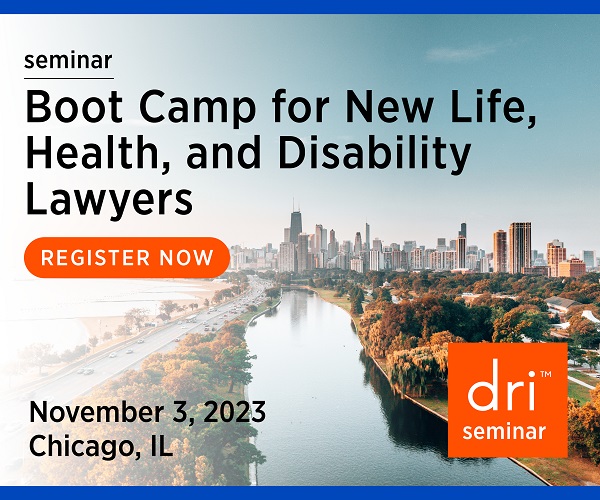Life, Health, and Disability News
Fourth Circuit Holds That a Plaintiff May Recover Money Damages Through Equitable Relief Under ERISA § 502(a)(3) Based on a Defendant’s Unjust Enrichment as Long as The Unjust Gains Remain in the Defendant’s Possession or Can Be Traced to Other Assets
By Scott Trager
In Rose v. PSA Airlines, Inc., - - - F.4th - - -, No. 21-2207, 2023 WL 5839282 (4th Cir. Sept. 11, 2023), appellant, Jody Rose (“Ms. Rose”) appealed the dismissal of claims under ERISA §§ 502(a)(1)(B) and 502(a)(3) by the United States District Court for the Western District of North Carolina following the death of her son, Kyree, a flight attendant for appellee, PSA Airlines (“PSA”), due to myocarditis. The Fourth Circuit, in addressing when, and under what conditions, a plaintiff may seek monetary relief under ERISA §§ 502(a)(1)(B) and 502(a)(3), in a 2-1 decision, affirmed the district court’s dismissal of the § 502(a)(1)(B) claim and vacated the district court’s dismissal of the § 503(a)(3) claim and remanded the issue for the district court to determine whether Ms. Rose has, or can, plausibly allege such a claim.
PSA ran a fully self-funded health and welfare benefit plan under which it served as plan administrator and fiduciary. The other appellees, UMR, Inc., Quantum Health, Inc., and MCMC, LLC, helped PSA provide administrative services for the plan, including reviewing benefits claims. When doctors discovered Kyree’s heart condition, they determined he needed a heart transplant to survive and prepared to proceed with surgery once his benefits claim was approved. Appellees, after multiple reviews, denied the benefits claim. Kyree’s doctors thereafter sought an expedited external claim review, which was conducted by MCMC. MCMC, however, treated the review as a standard review. Kyree died a little over a week after submitting the review application (five days after an expedited decision should have been rendered). Almost a month after Kyree’s death, however, MCMC overturned the previous claim denials. Ms. Rose, as administratrix of Kyree’s estate, sued PSA, the plan, and the other appellees, seeking relief for a wrongful denial of benefits under ERISA § 502(a)(1)(B) and for breach of fiduciary duty under § 502(a)(3). The district court dismissed both claims under Fed. R. Civ. P. 12(b)(6) and Ms. Rose appealed to the Fourth Circuit which reviewed the district court’s dismissal de novo.
The Fourth Circuit held that Ms. Rose was not authorized under § 502(a)(1)(B) to seek the monetary cost of Kyree’s surgery because that section only allows a plaintiff to recover benefits due under the terms of the plan or to enforce one’s rights under the terms of the plan. The benefit that Kyree would have received under the terms of the plan would have been the surgery, which he never received, not a direct monetary payment. Accordingly, the Fourth Circuit held the district court correctly dismissed the § 502(a)(1)(B) claim because Ms. Rose sought to recover the monetary cost of a benefit which was never provided.
The court next addressed the viability of the § 502(a)(3) claim, specifically whether the relief sought – the monetary cost of the surgery that her son was wrongfully denied – qualified as “equitable relief.” The court found the district court was correct not to give Ms. Rose the cost of the surgery as compensation for Kyree’s death. But Ms. Rose also alleged appellees were unjustly enriched by keeping the money they should have paid to Kyree’s doctors. To answer that question, the court considered the distinction between legal and equitable remedies and recognized there are many monetary equitable remedies. This raised the question of whether equitable remedies that look like money damages constitute “equitable relief” under ERISA. After reviewing several prior Supreme Court decisions addressing how to interpret “equitable relief” (Mertens v. Hewitt Assocs., 508 U.S. 248 (1993); Great-West Life & Annuity Ins. Co. v. Knudson, 534 U.S. 204 (2002); Montanile v. Board of Trustees of the Nat’l Elevator Indus. Health Benefit Plan, 577 U.S. 136 (2016)), the court concluded that a plaintiff can recover money under § 502(a)(3) only when a plaintiff points to specific funds he rightfully owned but the defendant possessed as a result of unjust enrichment. Thus, a plaintiff seeking merely personal liability upon a defendant to pay a sum for money asks for legal, not equitable, relief under § 502(a)(3). On the other hand, a plaintiff seeking to strip away a defendant’s unjust gains seeks equitable relief as long as the plaintiff can trace those unjust gains to specifically identified funds remaining in the defendant’s possession or against traceable items that the defendant purchased with the funds.
The Fourth Circuit, therefore, agreed with the district court that compensatory “make-whole” monetary relief is unavailable under § 502(a)(3). The district court, however, did not consider whether Ms. Rose plausibly alleged facts that would support relief that was typically available in equity, such as unjust enrichment. This would require her to allege facts showing that a defendant was unjustly enriched by interfering with Kyree’s rights and that the fruits of that unjust enrichment remained in the defendant’s possession or could be traced to other assets. The court remanded for the district court to decide in the first instance whether Ms. Rose satisfied that burden for each defendant.
Judge Heytens, who concurred in part and dissented in part, agreed that the district court correctly dismissed the § 502(a)(1)(B) claim and that the § 502(a)(3) claim should be remanded for further proceedings, but stated that Ms. Rose was not required to show the fruits of a defendant’s wrongdoing are traceable to particular funds remaining in that defendant’s possession to state a claim under ERISA. Rather, he opined, following Cigna Corp. v. Amara, 563 U.S. 421 (2011), and reconciling Peters v. Aetna Inc., 2 F.4th 199 (4th Cir. 2021) with McCravy v. Metropolitan Life Ins. Co., 690 F.3d 176 (4th Cir. 2012), that she needed only to plead and prove the defendant was a fiduciary and that any money sought represents “make-whole relief” for a violation of a duty imposed upon that fiduciary.
 Scott Trager is a Partner at Funk & Bolton PA. His practice covers a broad spectrum of general litigation matters in the state and federal courts of Maryland and the District of Columbia, as well as the Maryland Insurance Administration and Maryland Office of Administrative Hearings. He focuses his practice on the defense of life, health and disability insurance claims (ERISA and non-ERISA), as well as administrative claims before insurance regulators. He also has extensive experience with policy rescissions and interpleaders. He is the Immediate Past Chair of DRI's Life, Health and Disability Committee, and previously served as Committee Vice-Chair (2018-2020) and Program Chair of the 2017 DRI Life, Health, Disability & ERISA Seminar.
Scott Trager is a Partner at Funk & Bolton PA. His practice covers a broad spectrum of general litigation matters in the state and federal courts of Maryland and the District of Columbia, as well as the Maryland Insurance Administration and Maryland Office of Administrative Hearings. He focuses his practice on the defense of life, health and disability insurance claims (ERISA and non-ERISA), as well as administrative claims before insurance regulators. He also has extensive experience with policy rescissions and interpleaders. He is the Immediate Past Chair of DRI's Life, Health and Disability Committee, and previously served as Committee Vice-Chair (2018-2020) and Program Chair of the 2017 DRI Life, Health, Disability & ERISA Seminar.
Interested in joining the Life, Health, and Disability Committee? Click here for more information.
Print this section
Print the newsletter
Young Lawyers: Raising the Bar
Fighting the Good Fight, In Limine Motions
By Michael E. Tuttle
As a Defendant on the eve of trial, after a Court has ruled that a Jury could reasonably render a Plaintiff’s verdict, it is the Defense’s last significant opportunity to convince the Court to exclude Plaintiff’s spurious trial-evidence. Effective in limine motions alert the Court to the aspects of Plaintiff’s case-in-chief, that if admitted, would unduly confuse the facts at issue, mislead the Jury’s decision-making, or otherwise unfairly prejudice the Defense. See FRE § 403. Case law recognizes motions in limine (Latin for “on the threshold” of trial) as the procedural mechanism to warn the Trial Court about potential evidence that, if admitted, would be more prejudicial than probative. Additionally, efficacious in limine motions minimize the real danger that a Jury might base its decision on emotion or remove non-party distractions from the Jury’s consideration and “thereby reliev[e] the trial judge from the formidable task of neutralizing the taint of prejudicial evidence.” Brodit v. Cambra, 350 F.3d 985, 1004-05 (9th Cir. 2003).
Among the countless ways a Defendant could imagine restricting a Plaintiff prosecution of the case, a Defendant’s in limine motions ought to focus on only those issues that have significant and thematic importance to the case and to the litigation at large and reserve otherwise minor objections for trial. A Defendant may be tempted to raise every potential bit of evidence that might unfairly influence the Jury – however, the Court will perceive a litany of in limine motions as an attempt to improperly rehash prior rulings within the case or as a misuse of the in limine process. Motions in limine should be crafted with the intent to streamline the trial by disposing of significant evidentiary issues at the outset; not for banal, garden-variety evidentiary issues best addressed during trial. Crafting focused in limine motions requires that a Defendant be steeped in the specific evidentiary issues of the case and alert the Court to the Plaintiff’s most incriminatory and unfairly prejudicial evidence.
Within the context of toxic tort litigation, there are numerous topics worthy of Defendants’ in limine motions, however, below is an analysis of two recent evidentiary issues that, if admitted, would likely be more prejudicial than probative to the Jury’s verdict, confuse the facts at issue, mislead the Jury’s decision-making.
Science, Tailor-Made for Litigation
Plaintiffs in prior litigation against cosmetic talc manufacturers have proffered so-called “scientific” articles authored by litigation experts who have long histories of retentions by plaintiffs’ firms. A 2020 article entitled, Mesothelioma Associated With the Use of Cosmetic Talc (the “2020 Article”) and a follow-up 2023 article entitled, Exposure to Cosmetic Talc and Mesothelioma (the “2023 Article”) (collectively, the “Articles”), both published in the Journal of Occupational and environmental Medicine, are both tailor-made litigation articles authored by a plaintiffs’ expert in an attempt to elevate the status of a multitude of allegations to the stature of “science.” The Articles claims that 155 litigant (33 litigants from the 2020 Article and 122 litigants from the 2023 Article) used talc powder and developed mesothelioma in the absence of any exposure to asbestos, other than exposure to cosmetical talcum powder products.
The unreliability of the 2020 Article was recently laid bare in the District Court for the Middle District of North Carolina. Bell v. Am. Int’l Indus. et al., No. 1:17-CV-00111 (M.D.N.C. Sept. 13, 2022), ECF No. 398 at 4, 17, 22 (the “Bell Opinion”). The Bell Opinion criticized the 2020 Article for “conceal[ing]” information about occupational asbestos exposures of Betty Bell – a litigant who was included within the 2020 Article. Id. at 16-18, 20. The District Court found that the inclusion of an individual with asbestos exposures apart from her exposure to allegedly contaminated talc had “direct bearing on the study’s credibility” as it contradicted the entire foundation of the 2020 Article. The District Court also expressed grave concern about the “groundbreaking nature” and “widespread influence” of the 2020 Article “on the cosmetic talc litigation nationwide” given that this critical information had been shielded from public disclosure until the Bell Opinion was issued. Id.
The 2023 Article is a compendium of information from plaintiffs’ attorneys within talc litigation in matters in which the Articles author was a paid plaintiffs’ expert. See Dep. Tr. of Plaintiff’s Expert, Ortiz, et. al. v. Colgate-Palmolive, Co. et al., Sup. Ct. of Cal., Los Angeles Co., No. 19STCV31844 (Mar. 10, 2023) at 57. The Bell Opinion noted that without any indicia of reliability, plaintiffs’ attorneys sought to admit these Articles as evidence that each of the litigants who were diagnosed with mesothelioma had used cosmetic talcum powder and had no exposure to asbestos. Id. at 67 to 69. A properly crafted in limine motion would focus the Court’s attention on such an issue that would surely confuse a Jury’s decision making.
These Articles are iterations of a long-running trend of experts leveraging their credentials to fabricate “science” in service of plaintiffs’ attorneys in mass tort litigation. Experts contrive baseless opinions, which plaintiffs’ lawyers then use to confuse juries, secure extreme verdicts, and in turn pay these same experts. These Articles would not only create significant prejudice to Defendants, but also will confuse the issues and mislead the jury.
Experts Need Oversight Too
There are locations and sites, such as Libby, Montana and the Brooklyn Navy Yard, that are well known flashpoints of substantial asbestos exposures which have served as unique epicenters of healthcare and research into the health hazards associated with exposure to asbestos. In 2002, the EPA declared the area around Libby, Montana a Superfund site and then in 2009 declared a Public Health Emergency in the area to trigger the flow of federal healthcare assistance. See EPA Superfund Site: Libby Asbestos Site, Libby, MT (https://cumulis.epa.gov/). The Center for Asbestos Related Disease (“CARD”), located in Libby, Montana is a federally-funded health clinic that provides healthcare and engages in research regarding exposure to amphibole asbestos. The clinic has certified more than 3,400 people with asbestos-related diseases and received more than $20 million in federal funding, according to court documents. See BNSF Ry. Co. v. Ctr. For Asbestos Related Disease, No. CV 19-40-M-DLC (D. Mont. Jul. 6, 2021) ESF No. 40. In addition to its federal funding, CARD has also been funded by Mount Sinai School of Medicine, an institution with which many plaintiffs’ experts are affiliated.
Recently, a Jury in the U.S. District Court for Montana returned a verdict finding that CARD had committed 337 violations of the False Claims Act and awarded over one million dollars in damages. See BNSF Ry. Co. v. Ctr. For Asbestos Related Disease, No. CV 19-40-M-DLC (D. Mont. Jul. 6, 2023) ESF No. 216. The plaintiff in this case, BNSF, has been a defendant in hundreds of asbestos-related lawsuits. BNSF successfully proved that CARD fraudulently received federal funding related to unnecessary treatments of individuals without sufficient confirmation of any asbestos-related disease. In association with other institutions, CARD developed false asbestos-disease research based on erroneous data points from asbestos-related medical treatment of hundreds of individuals without any confirmed asbestos-related diseases.
Admitting evidence of “research” and “science” produced from decades of CARD’s fallacious treatment of individuals without confirmed asbestos-related diseases, as well as any subsequent research that relied on CARD’s erroneous data, would surely obfuscate the truth of the issues for any Jury that considered such evidence. Admitting this “evidence” would create obvious undue prejudice for any Defendant. To some Jurors, so-called “scientific proof” may bestow a cloak of infallibility on what has been proven to be false research. An effective in limine motion would seek to exclude demonstrably unfair evidence from the trial. Reliable medical research and the underlying scientific data is what a Jury ought to consider as “evidence.” To the extent a Jury is charged with deciding the “actual” facts of a toxic tort case based on scientific proof, it is the Defendant’s duty and the Court’s responsibility to ensure the Jury’s decision-making is fair.
Conclusion
To put a finer point on it, a motion in limine should not be filed unless the issue is significant at the threshold of trial and there is a high likelihood of a favorable ruling. Aside from the risk of irritating the Court with a trite motion, worse yet, a motion in limine may reveal deficiencies in an opponent’s evidence that may be more aptly opposed with objections during trial or through cross-examinations. Laying bare a defense strategy within a motion in limine that is not likely to prevail only provides an opponent with an opportunity to more effectively position their dubious evidence to avoid sustained objections. It is critical that the motion is both worthy of pre-trial review and is likely to receive a favorable ruling. Successful in limine motions are an effective way to put forth a favorable record to the Jury and in some instances, may reduce the value of Plaintiff’s case and encourage a favorable settlement before trial.
 Michael E. Tuttle, Esq. is an Associate with Foley & Mansfield, PLLP in the NYC Office. His practice is exclusively devoted to defending businesses of all sizes against mass tort claims, toxic tort claims, and product liability claims as well as coordinating national defense strategies. Michael is a member of DRI and has served as the Vice Chair of The Brief Case Subcommittee.
Michael E. Tuttle, Esq. is an Associate with Foley & Mansfield, PLLP in the NYC Office. His practice is exclusively devoted to defending businesses of all sizes against mass tort claims, toxic tort claims, and product liability claims as well as coordinating national defense strategies. Michael is a member of DRI and has served as the Vice Chair of The Brief Case Subcommittee.
Interested in joining the Young Lawyers Committee? Click here for more information.



